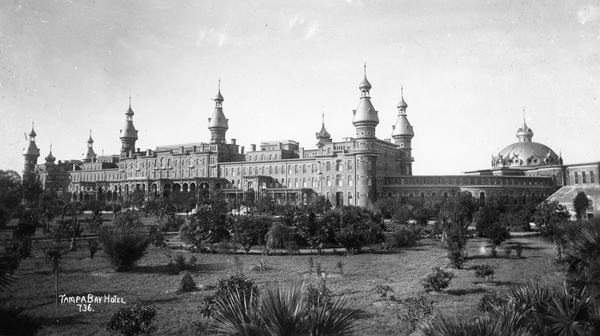Tampa, Florida
 The Expedition was backed by Henry B. Plant, and the idea for the exploration trip was developed at a meeting with Plant in Tampa. James E. Ingraham was President of Sanford's South Florida Railroad, which had been acquired in 1884 by Plant. Throughout the Expedition Ingraham sent telegrams to Plant in Tampa with updates on their progress. From the 1870s to the 1890s Plant built up the Plant System, which included railway and steamship lines, as well as hotels. In 1891, Plant opened the grand resort hotel, the Tampa Bay Hotel, on the Hillsborough River near the center of the city. Port Tampa, the transportation hub for these rail and steamship lines, was about nine miles south of the city of Tampa.
The Expedition was backed by Henry B. Plant, and the idea for the exploration trip was developed at a meeting with Plant in Tampa. James E. Ingraham was President of Sanford's South Florida Railroad, which had been acquired in 1884 by Plant. Throughout the Expedition Ingraham sent telegrams to Plant in Tampa with updates on their progress. From the 1870s to the 1890s Plant built up the Plant System, which included railway and steamship lines, as well as hotels. In 1891, Plant opened the grand resort hotel, the Tampa Bay Hotel, on the Hillsborough River near the center of the city. Port Tampa, the transportation hub for these rail and steamship lines, was about nine miles south of the city of Tampa.
In the late 1880s Tampa became a major commercial city, exporting cigars and phosphate amongst other goods. Tampa is located on the Gulf coast at the mouth of the Hillsborough River on Tampa Bay. The site was established with a military fort, Fort Brooke, in the 1820s, but only a few settlers arrived over the next few decades. In 1849 the settlement incorporated as the Village of Tampa, and in 1855 reincorporated as the city of Tampa. The population did not grow substantially until the 1880s with the arrival of railroad and steamship lines. The population for the Tampa metropolitan area was 5,532 according to the 1890 Census. The population tripled by 1900, aided by Tampa's prominent role in the Spanish American War a year earlier.
Credits:
Sources:
References in the Texts:
Links below open in a new browser window.
For other topics referenced in the Expedition texts, please refer to the Index to Subjects and Names.
1892 Everglades Exploration Expedition : Three Digital Texts, 2015
 The Expedition was backed by Henry B. Plant, and the idea for the exploration trip was developed at a meeting with Plant in Tampa. James E. Ingraham was President of Sanford's South Florida Railroad, which had been acquired in 1884 by Plant. Throughout the Expedition Ingraham sent telegrams to Plant in Tampa with updates on their progress. From the 1870s to the 1890s Plant built up the Plant System, which included railway and steamship lines, as well as hotels. In 1891, Plant opened the grand resort hotel, the Tampa Bay Hotel, on the Hillsborough River near the center of the city. Port Tampa, the transportation hub for these rail and steamship lines, was about nine miles south of the city of Tampa.
The Expedition was backed by Henry B. Plant, and the idea for the exploration trip was developed at a meeting with Plant in Tampa. James E. Ingraham was President of Sanford's South Florida Railroad, which had been acquired in 1884 by Plant. Throughout the Expedition Ingraham sent telegrams to Plant in Tampa with updates on their progress. From the 1870s to the 1890s Plant built up the Plant System, which included railway and steamship lines, as well as hotels. In 1891, Plant opened the grand resort hotel, the Tampa Bay Hotel, on the Hillsborough River near the center of the city. Port Tampa, the transportation hub for these rail and steamship lines, was about nine miles south of the city of Tampa.